Introduction
Polyethylene mulch has been used commercially on vegetables since the early 1960s. Currently, polyethylene mulch is used on thousands of acres of vegetables in the United States. Florida leads in use with about 100,000 acres of mulched vegetables.
In Florida, the vast majority of mulch is used in southern Florida on tomatoes, peppers, eggplants, strawberries, and melons. In northern Florida, very little mulching was practiced until the late 1980s, except for tomatoes in the Quincy area and strawberries in Bradford County. Mulching practices have since steadily increased throughout the rest of North Florida on a wide range of vegetable crops, including watermelon, cantaloupe (muskmelon), tomato, cucumber, pepper, and eggplant.
Types of Mulch
Basically, three major colors of mulch have been used commercially: black, clear, and white (or white-on-black). Recently, several other colored mulches have been researched, including silver, aluminized, red, blue, yellow, green, and others. Black mulch is used most widely because it retards weed growth, resulting in less chemical usage. Black is popular for cool seasons because it warms the soil by contact. Clear polyethylene is used widely in the northern United States because it promotes warmer soil temperatures by heating soil directly and trapping the heat by the greenhouse effect more effectively than black mulch. Clear mulch requires use of labeled fumigants or herbicides underneath to prevent weed growth, unless it is used for solarization. Clear mulch is not used much in Florida because of the higher temperatures and weed growth underneath. White or white-on-black mulch is used for fall crops, which are established under hot summer conditions. Soils under white mulch or white-on-black mulch remain cooler because the mulch absorbs less radiant energy. Some growers create their own "white" mulch by painting the surface of black-mulched beds with white latex paint or other similar products, a common practice where fall crops are double-cropped on black mulched beds of a spring crop. Highly reflective silver or metalized coatings on polyethylene have become important in North Florida and South Georgia as a method of reducing thrips and tomato spotted wilt virus in tomato crops. These mulches repel the tomato spotted wilt virus vectors, western flower thrips, (Frankliniella occidentalis) and the tobacco thrips (F. fusca). Only small acreage of other colored mulches are used in the United States. Consistent repeated benefits with most colored mulches have been difficult to find.
Benefits of Mulch
- Increases early yields. The largest benefit from black polyethylene mulch is the increase in soil temperature in the bed, which promotes faster crop development and earlier yields. For growers in northern Florida, this means producing a crop in between the time that southern Florida growers and growers to the north in Georgia and South Carolina produce their crops. Growers in these states to the north have adopted mulch and are producing crops earlier that compete with northern Florida growers who do not use mulch.
Research has been conducted over several years at the North Florida Research and Education Center in Live Oak and Quincy on the effect of black mulch on watermelon production. Results indicate mulching consistently produces higher earlier yields. In addition, in about half of the years, higher total yields were also attained in mulched watermelon versus no mulch. The use of transplants and polyethylene mulch resulted in the highest early yields.
2. Aids moisture retention. Mulch reduces evaporation from the bed soil surface. As a result, a more uniform soil moisture regime is maintained and the frequency of irrigation is reduced slightly. Irrigation is still mandatory for mulched crops so that the soil under the mulch doesn't dry out excessively. Scheduling aids such as tensiometers or resistance blocks placed in the bed between plants can help indicate when irrigation is needed. Almost all polyethylene mulch used in North Florida is used in combination with drip irrigation. Overhead irrigation on mulched beds in deep sands is very challenging. It is critical to keep up with irrigation demands when using overhead irrigation.
3. Inhibits weed growth. Black, white-on-black, and silver-on-black mulches greatly inhibit light penetration to the soil. Therefore, weed seedlings cannot survive under the mulch. Nutsedge can still be a problem, however. The nuts (tubers) provide enough energy for the young nutsedge with sharp leaves to puncture the mulch and emerge. Other pests, such as soilborne pathogens, insects, and nematodes, are not reduced by most mulches. Some benefit has been shown from high temperatures under clear mulch when used for solarization. Research on solarization is continuing at the University of Florida. Currently, the best measure for nutsedge and pest control under the mulch is labeled fumigation. The loss of methyl bromide fumigation will make nutsedge control difficult in many vegetable crops.
4. Reduces fertilizer leaching. Fertilizer placed in the bed under the mulch is less subject to leaching by rainfall. As a result, the fertilizer program is more efficient and the potential exists for reducing traditional amounts of fertilizer. Heavy rainfall that floods the bed can still result in fertilizer leaching. This fertilizer can be replaced if the grower is using drip irrigation, or it can be replaced with a liquid fertilizer injection wheel.
5. Decreases soil compaction. Mulch acts as a barrier to the action of rainfall, which can cause soil crusting, compaction, and erosion. Less-compacted soil provides a better environment for seedling emergence and root growth.
6. Protects fruits. Mulch reduces rain-splashed soil deposits on fruits. In addition, mulch reduces fruit rot caused by soil-inhabiting organisms, because there is a protective barrier between the fruit and the organism.
7. Aids fumigation. Mulches increase the effectiveness of soil fumigant chemicals. They do not provide a barrier but allow a water layer to form under the mulch and it is this water layer that slows down the loss of the fumigant. Virtually impermeable films (VIFs) have recently come on to the market as a new mulch film technology for improving fumigant gas capture under the mulch.
8. Aids in managing other pests. Highly reflective mulches assist pest management strategies for pests and the diseases, especially viruses, they may carry. Metalized mulches have been shown to repel thrips and reduce incidence of tomato spotted wilt virus in tomatoes.
Negative Aspects of Mulch
- Mulch removal and disposal. The biggest problems associated with mulch use are removal and disposal. Since most mulches are not degradable, they must by removed from the field after use. This usually involves some hand labor, although mulch lifting and removal machines are available (Fig. 1). Some machines are available to compact and bale the used mulch. Some growers in Florida have been burning the mulch in place on the bed, but the buried edges still must be removed by hand. Disposal also presents a problem because of the quantity of waste generated. Modern polyethylene mulch films are considerably thinner in gauge. While older mulches were as thick as 1.5 mil, today's mulches can be as thin as 0.4 mil. Thinner mulches result in less quantity of film to be disposed. Degradable mulches are available and most are photodegradable. As a result, the buried tuck does not begin to degrade until it is lifted and exposed to the sun. These have been available but not widely used in Florida except for single crop watermelon or cantaloupe. Recycling of polyethylene is possible but crop mulches present problems with the soil, pesticide, and fruit residues on the mulch.
- Specialized equipment. The mulch cultural system requires an investment in some specialized equipment, including a bed press, mulch layer, and mulch transplanter or plug-mix seeder. Vacuum seeders are also available for seeding through mulch. This equipment is not very expensive, is easily obtained, and some can even be manufactured on the farm.
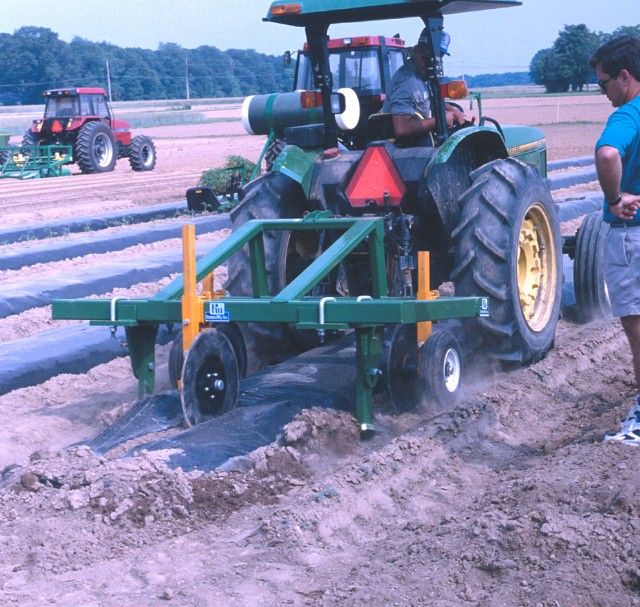
Credit: UF/IFAS
Mulch Application
For commercial operations, mulch is applied by machine. There are machines that prepare beds, fertilize, fumigate, lay drip tape, and mulch in separate operations or in combination. The best option is to complete all operations in one pass across the field. Figure 2 shows a bed press and pan type mulch applicator. Figure 3 shows a one-pass combination mulch layer.
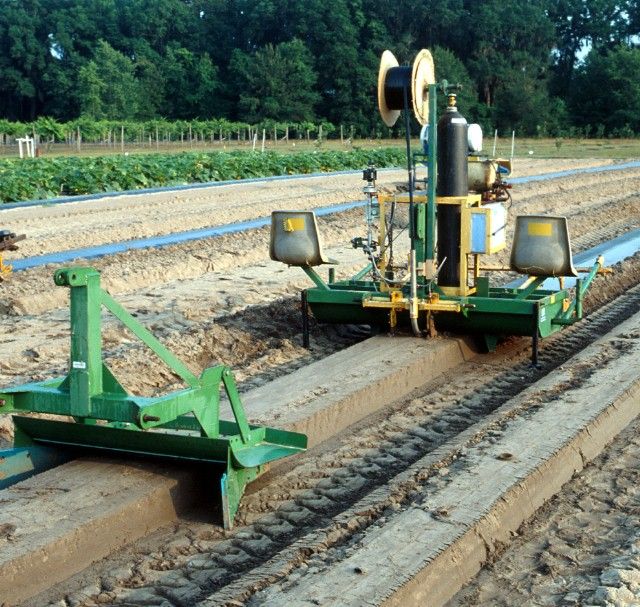
Credit: UF/IFAS

Credit: UF/IFAS
In general, all chemicals and some fertilizers are applied to the soil before or at the time of mulching. Incorporation can be done with a rototiller, rolling cultivator, or bedding disc. If drip irrigation is used, incorporate all phosphorus and micronutrients and about 20 to 30 percent of the nitrogen and potassium fertilizer in the bed. Apply the remainder of the nitrogen and potassium through the drip tubes. Fertilizer amounts are those indicated from a soil test through the UF/IFAS Extension Soil Testing Laboratory in Gainesville.
When laying mulch, be sure the bed is pressed firmly and that the mulch is in tight contact with the bed. This helps transfer heat from mulch to bed and reduces flapping in the wind, which can result in tears and blowing of mulch from the bed and injury to transplants. It is critical to adjust the mulch layer so that the edges are buried sufficiently to prevent uplifting by wind. Check fumigant knives regularly for plugging.
Soil Preparation
It is critical to have well-prepared soil for a high-quality mulched bed. Large clumps of grass, sod, weeds, or soil make it impossible to lay plastic tightly to a bed. Prepare the soil well in advance of mulching. Plowing and rototilling generally prepare soil well for mulching. Discing alone in grass pasture fields is not generally sufficient to properly prepare the soil.
Bed Height and Width
Bed height is related to the amount of flooding potential in the field. In northern Florida, it is not expected that a bed higher than 4 to 6 inches will be needed in most areas. If there is no history of a high water table, then the bed only needs to be high enough to permit rain drainage from the bed surface and to facilitate tight application of the mulch to the bed. Excessively high beds are prone to rapid drying and can be difficult to re-wet.
The width of the bed will depend on the crop, the number of rows desired per bed, and the cost of the mulch. For example, beds 2 feet wide can accept 4-foot mulch sheets and can be used for vegetables, as shown in Figure 4.

Credit: UF/IFAS
Beds 24 to 36 inches wide can be used for tomatoes, eggplants, squash, and muskmelons, among others. Double rows of peppers or squash can easily be planted on 3-foot-wide beds, but can also be planted on beds as narrow as 2-feet. The preference has been for narrow beds of 24 to 30 inches due to the cost of mulch and fumigants and ease of application.
Planting the Crop
Vegetable crops can be established in mulch by transplanting or direct-seeding. Transplanting can be accomplished by mechanical planters or with semi-automated transplanters. A water-wheel manual transplanter is shown in Figure 5. A semi-automatic transplanter is shown in Figure 6. The transplanters can place plants at various spacings, and can apply water or fertilizer solution with the plants. When establishing transplants, be sure the plant is upright and the stems do not touch the plastic or the heat from the mulch can burn the stem.
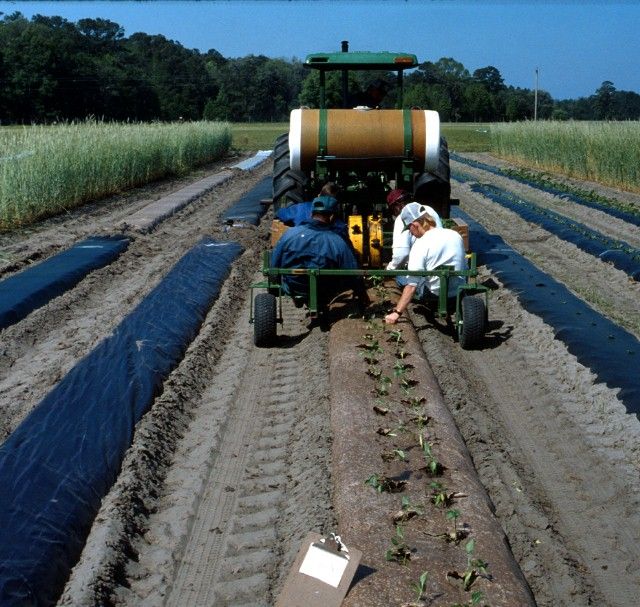
Credit: UF/IFAS

Credit: UF/IFAS
Direct-seeding through mulch can be accomplished by hand. A second method is the "plug-mix" planter, as shown in Figure 7. A third option is to direct-seed with a mechanical plate seeder (Figure 8). Seed is mixed with a peat-vermiculite (potting soil) material, wetted, and placed in the hopper on the planter. The machine punches a hole in the polyethylene mulch and places a small amount of the "plug-mix" into the hole. New vacuum seeders have recently been developed that will place individual seeds through the mulch. The vacuum seeders offer great potential for seeding large acreages.
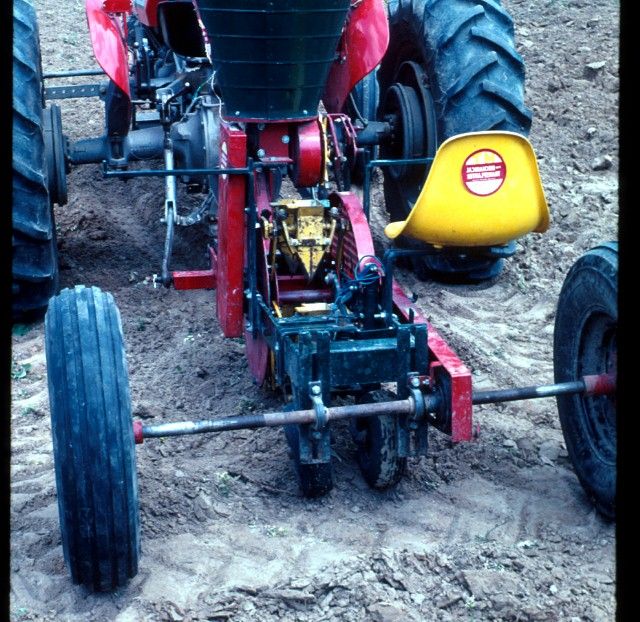
Credit: UF/IFAS
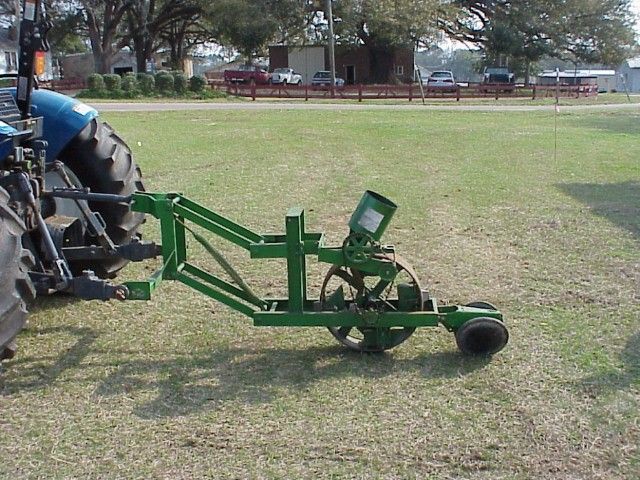
Credit: UF/IFAS
Cultural Systems Using Mulch
Other production techniques can supplement the effects of polyethylene mulch for producing early crops in an intensive, technological culture system. Transplants often help secure extra days of earliness. Compare the extra growth attained by transplanted watermelons on mulch to the growth of trays planted watermelons without mulch in Figure 9. Seed costs of many crops such as seedless watermelon have made transplants more economical than direct-seeding. In addition, transplants permit exact plant populations to be achieved without thinning, which is often required with direct-seeding. Windbreaks such as rye should be used to reduce sandblasting of young plants and to help reduce the cooling effect of wind.
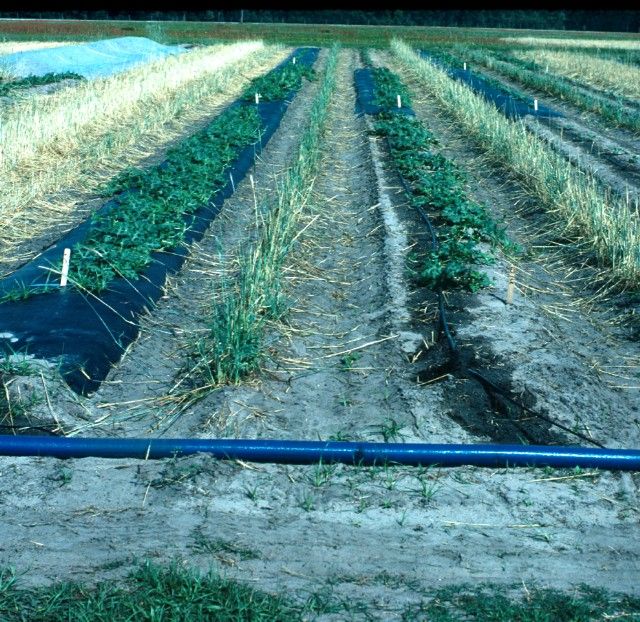
Credit: UF/IFAS
Drip irrigation fits in well with polyethylene mulch, because the grower can maintain optimum moisture under the mulch and the irrigation can be computer-controlled. In addition, drip irrigation provides a method to fertilize the crop so that large amounts of pre-plant fertilizer are not needed. Spoon-feeding the crop with drip irrigation is a more efficient method of fertilization and reduces the potential for large-scale leaching losses of fertilizer.
Double-cropping with mulch is made easier when drip irrigation is used. No longer is the application of extra fertilizer needed when planting the first crop to ensure a residual for the second crop. With drip irrigation, the second crop can be fertilized on its own.
Row covers, in conjunction with mulch, have been shown to produce the earliest yields (Figure 10). This system appears to hold promise for the intensive production of certain high value vegetable crops for retail sales.

Credit: UF/IFAS
More Information
For more information on the basics of the mulch system for vegetable production, contact your local UF/IFAS Extension office. Demonstrations of this technology are ongoing at the UF/IFAS North Florida Research and Education Center—Suwannee Valley. To inquire about testing this technology on your farm, contact your local UF/IFAS Extension agent.
Visit Small Farms and Alternative Enterprises: https://smallfarms.ifas.ufl.edu/